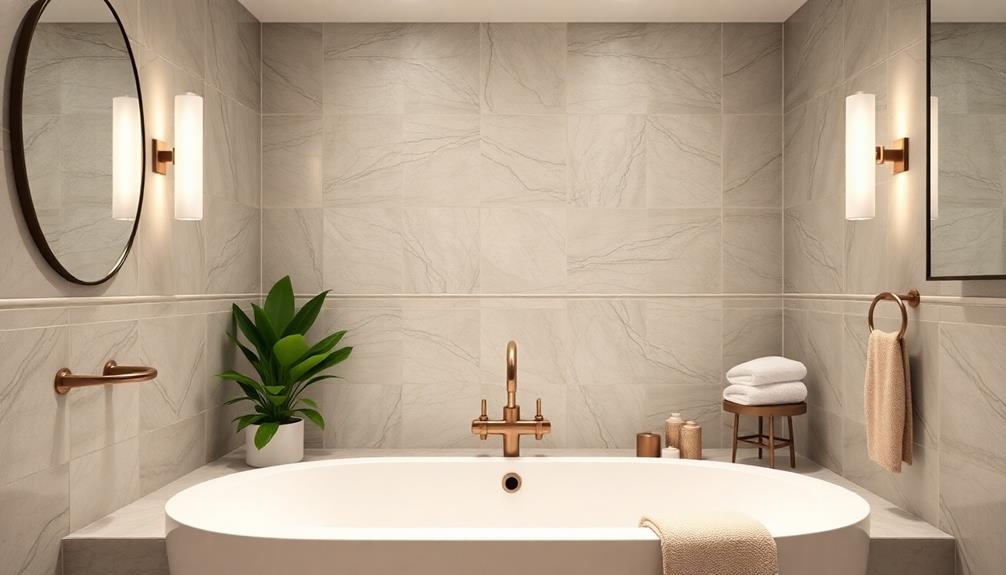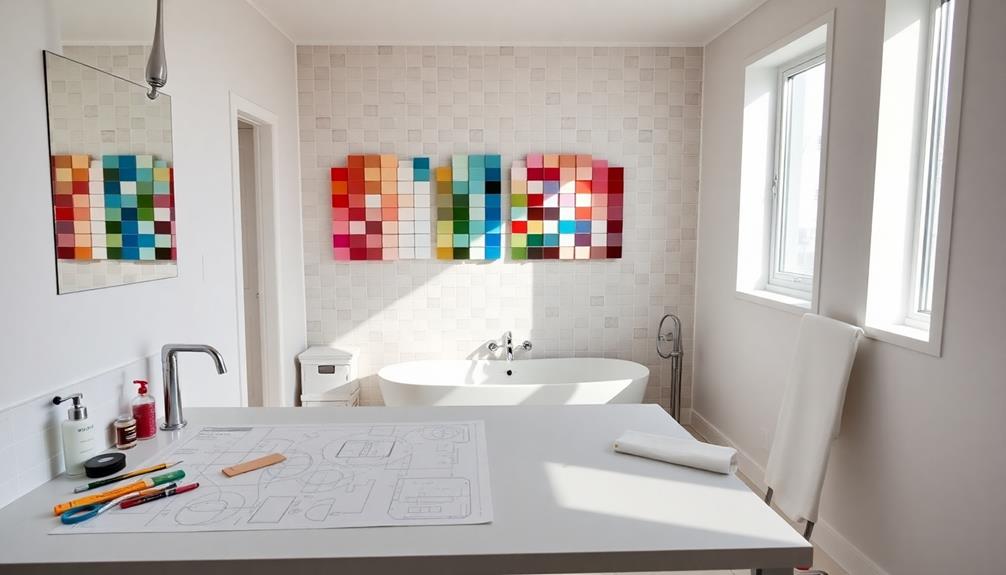To receive an estimate for a bathroom remodel, the first step is to understand the costs involved, which typically range from $10,000 to $25,000. Compile a detailed breakdown of labor and material expenses, taking into account labor costs and current material prices. It is advisable to set aside a contingency fund of 10-20% for any unexpected expenses that may arise. Communicate with clients to clearly understand their needs and preferences. Transparency is key when discussing potential additional costs, ensuring open communication throughout the entirety of the project. Use efficient estimation tools to make precise calculations. For more insights on effectively managing your bathroom remodeling project, there is a wealth of information waiting to be discovered.
Key Takeaways
- Estimate total costs by considering labor (20%), materials (60%), and a contingency fund of 10-20% for unexpected expenses.
- Conduct thorough consultations to capture customer preferences, needs, and budget for accurate quoting.
- Use itemized lists to detail labor and material costs, ensuring transparency and clarity in estimates.
- Incorporate a gross profit margin of 35-38% into your estimates to maintain profitability while covering specialty expenses.
- Regularly update your pricing database and utilize estimation tools for accurate and timely quotes based on current market conditions.
Understanding Bathroom Remodeling Costs
Understanding bathroom remodeling costs can be overwhelming, but breaking it down makes it manageable. The average cost of a bathroom remodel typically ranges from $10,000 to $25,000, while high-end remodels can soar beyond $50,000.
Labor costs usually account for about 20% of your total expenses, averaging between $1,300 to $4,300, depending on your remodeling project's complexity. It's important to be aware of the various financial terms and jargon that can affect your budget, such as interest rates which may impact any loans you consider for funding the remodel.
Materials chosen play a significant role, often comprising 60% or more of your total costs. This can range from $2,000 to $10,000 for a full bathroom remodel.
When budgeting, keep in mind that full bathroom remodels usually cost between $120 to $275 per square foot, influenced by both the quality of materials and local labor rates.
Using a cost estimator can help you outline your project budget effectively. Additionally, it's wise to factor in unexpected expenses, so set aside a contingency fund of 10-20% of your total project cost.
Estimating Labor and Material Expenses

When estimating labor and material expenses for your bathroom remodel, you'll want to analyze labor costs carefully, as they can greatly impact your budget.
Additionally, consider the best vacuums for dust removal in 2024 to guarantee your space stays clean during the renovation process.
Material pricing strategies are also essential, since they typically make up a large portion of your total expenses.
Labor Cost Analysis
Accurate labor cost analysis is crucial for your bathroom remodeling project, as it directly impacts your budget and overall profitability. Understanding labor costs, which typically range from $1,300 to $4,300, is key since they account for about 20% of the total project cost.
Additionally, considering the safety of your home during renovations is important, as the presence of security systems can deter potential intruders and provide peace of mind.
- Know the average hourly rates for plumbers ($45 to $150) and electricians ($40 to $100).
- Factor in potential interruptions that may affect productivity and costs.
- Use itemized lists for a clearer breakdown of labor expenses.
When estimating labor, always include plumbing fixtures and electrical costs, as these can greatly influence your bathroom remodel costs.
To guarantee profitability, consider incorporating a gross profit margin (GPM) of 35%-38% into your estimates. It's also wise to consult with suppliers for current material prices, providing a more accurate picture of your total project cost.
Material Pricing Strategies
Establishing effective material pricing strategies is crucial for your bathroom remodeling project to stay within budget and manage expenses.
Begin by maintaining a regularly updated standard price list for materials, as material costs typically range from $2,000 to $10,000. This usually constitutes 60% or more of your total remodel expenses.
Utilize itemized lists for a clear remodel cost breakdown, factoring in both labor rates—averaging $70 per hour—and material costs based on square footage calculations. A methodical approach to budgeting can enhance your project's overall success, as best practices in quality assurance can be applied to guarantee all aspects are considered.
Don't forget to capture customer preferences on materials to set clear expectations, helping you avoid disputes regarding costs.
When estimating your budget, account for potential unexpected expenses, such as structural issues or mid-project design changes, by adding an extra 10-20% to your total estimate.
Lastly, consult with suppliers to guarantee you're aware of current material prices, as these can vary considerably by region and impact your overall project budgeting.
Capturing Customer Requirements

Capturing customer requirements is crucial for a successful bathroom remodel. Start with a thorough consultation to understand your specific needs, preferences, and budget constraints. This initial step lays the groundwork for an accurate estimate and helps define the project scope.
A well-prepared consultation can maximize the outcomes of your discussions and lead to a more efficient design process, as highlighted in effective preparation.
- Use a detailed questionnaire to gather information on desired features, fixtures, and materials.
- Discuss any anticipated structural changes to align expectations with the proposed plan.
- Encourage the sharing of inspiration photos to clarify your vision for the bathroom layout and aesthetic.
Document all customer inputs meticulously. This information not only serves as the foundation for developing accurate cost estimates but also guarantees the remodeling projects stay on track.
By capturing customer requirements effectively, you can anticipate challenges and streamline the design process. Remember, the more precise you're in detailing your desired features and budget constraints, the smoother the project will unfold.
Your insights are crucial in determining the bathroom remodel cost and guaranteeing that the final outcome meets your expectations. By prioritizing clear communication, you'll set the stage for a successful remodel that reflects your personal style and functional needs.
Managing Specialty and Additional Costs

When you're quoting a bathroom remodel, it's essential to identify specialty expenses like unique fixtures that can greatly impact your budget.
Additionally, consider how financial planning for home improvements can mirror the strategies needed for assisted living expenses, emphasizing the importance of thorough budgeting.
You'll also want to calculate a contingency fund to cover unexpected costs, ensuring you're prepared for surprises.
Clear communication with clients about these potential extra expenses will keep the project on track and everyone informed.
Identifying Specialty Expenses
Bathroom remodeling can quickly become a financial juggling act, especially when it comes to identifying specialty expenses. These costs often add significant value to your project but can also lead to budget overruns if you're not careful.
Additionally, guaranteeing that your heating and cooling systems are efficient can help manage long-term operational costs, making it wise to take into account energy-saving features in your remodel planning.
Ponder these specialty expenses:
- Unique fixtures that elevate aesthetics
- Plumbing upgrades guaranteeing functionality
- Customized cabinetry tailored to your needs
When planning your remodel, don't overlook essential items like electrical work and permitting fees. These costs can vary widely, so it's vital to factor them into your overall budget.
Additionally, unforeseen structural issues, such as mold or outdated plumbing, may arise, so be sure to include a contingency fund of 10-20% of your total remodel budget.
To maintain profitability, aim for a gross profit margin (GPM) of 35%-38% based on project costs. This guarantees that specialty expenses are adequately covered while keeping your bottom line in check.
Calculating Contingency Funds
Planning for unexpected costs is essential in any remodeling project, and having a solid contingency fund can save you from financial headaches down the road.
It's recommended to budget 10-20% of your total remodeling cost for contingency funds. This amount can help cover unexpected expenses like structural issues or design changes that may arise mid-project.
Additionally, understanding potential cold medications interactions can be beneficial when managing personal health during a stressful remodeling process. Specialty items, such as unique fixtures or equipment rentals, should also be factored into your contingency budget. These costs can catch you off guard if you haven't planned for them.
Common overruns, including permitting fees and delays in material delivery, can be smoothed out by having funds readily available.
Before you start your project, conduct a thorough assessment of potential structural problems, such as plumbing or electrical issues. This evaluation helps you determine an appropriate contingency amount.
Keeping detailed expense records and regularly updating your estimates during the remodeling process is vital for effective management of your contingency funds.
Managing Unexpected Costs
To effectively manage unexpected costs in your bathroom remodeling project, budgeting an additional 10-20% of the total cost is essential.
This cushion helps cover unforeseen expenses like structural issues or design changes that can arise during the remodeling process. Additionally, evaluating potential mechanic shops for fuel injection cleaning can help you avoid unexpected vehicle maintenance costs if your project involves commuting.
Here are some key areas to examine when planning your budget for your bathroom:
- Specialty items: Unique fixtures and equipment rentals can greatly impact your overall costs.
- Cost overruns: Be prepared for unexpected delays in material delivery, which can increase both labor and material prices.
- Detailed records: Keeping track of all expenses throughout the project allows for ongoing adjustments to your budget.
Planning for Contingencies

When you're quoting a bathroom remodeling project, it's important to set aside extra funds for unexpected expenses. A well-planned contingency fund, typically 10-20% of your total budget, can help you manage risks effectively. Common issues like structural problems or design changes can arise, so it's vital to prepare.
Here's a simple breakdown of potential contingencies:
| Contingency Type | Impact | Budget Allocation |
|---|---|---|
| Structural Issues | Mold or plumbing problems | 30% of contingency fund |
| Design Changes | Mid-project alterations | 20% of contingency fund |
| Material/Labor Delays | Impact on timelines and costs | 50% of contingency fund |
Incorporating a detailed risk assessment into your initial estimate can help align client expectations. By discussing potential unexpected expenses upfront, you'll foster trust and transparency. Always emphasize the importance of finalizing designs before starting to minimize additional costs. Planning for contingencies not only safeguards your project but also enhances your credibility as a contractor.
Utilizing Effective Estimation Tools

Managing unexpected expenses is just one part of quoting bathroom remodeling projects; utilizing effective estimation tools can elevate your accuracy and efficiency. By leveraging the right tools, you can gain a clearer picture of the cost of your bathroom remodel and avoid pitfalls that come with inaccurate calculations.
In addition, making certain that your content is aligned with user intent can enhance your relevancy in search results, driving more potential clients to your services content relevance and authority.
- Use a bathroom remodel cost calculator for tailored estimates.
- Create itemized lists to enhance transparency for clients.
- Regularly update your price list to reflect current market costs.
With these tools, you can provide an estimated cost that reflects the average bathroom remodeling project in your area. Incorporate software designed for estimating costs based on square footage and material choices to guarantee accurate calculations.
Referencing RSMeans data can also refine your labor cost estimates, taking into account regional rates and productivity levels.
When you plan to remodel your bathroom, consider the cost of materials and labor, as well as plumbing lines, to offer a thorough quote. By implementing these strategies, you'll create competitive and reliable estimates that won't only impress your clients but also keep your projects on track.
Key Components of a Bathroom Remodel

A successful bathroom remodel hinges on several key components that can dramatically impact both cost and design.
First, consider the fixtures you'll be using, such as sinks, toilets, tubs, and showers. These choices not only define the style but also greatly influence your overall costs.
Next, flooring options are essential; whether you opt for tile, vinyl, laminate, or hardwood, keep in mind that average flooring costs range from $56 to $103 per 100 sq. ft.
Cabinetry and storage solutions are necessary for maximizing space and enhancing organization. You'll need to decide between custom or pre-fabricated options, as they can affect your budget and style.
Don't overlook lighting and electrical upgrades, which are important for creating a safe and inviting atmosphere. The costs here can vary widely based on your choice of fixtures and the installation complexity.
Lastly, plumbing updates are required for any major remodel, especially if you're relocating fixtures. Expect plumbing pipe installation to average between $500 and $2,000 per fixture, depending on the scope of work.
Communicating With Clients Effectively

Successful bathroom remodeling involves not only selecting the right components but also effectively communicating with your clients throughout the process. To guarantee a smooth experience, focus on these key areas:
- Differentiate between preliminary estimates and fixed-price proposals to set clear expectations.
- Regularly communicate updates on project timelines and any potential delays.
- Provide itemized lists of costs and materials for transparency.
By capturing detailed input from clients about their specific requests, you'll minimize disputes and clarify expectations.
It's essential to openly discuss the possibility of unexpected costs, advising clients to budget an additional 10-20% for contingencies. This preparation helps them avoid financial surprises down the line.
Maintaining open lines of communication is vital. Regular updates not only keep clients informed but also help manage their expectations.
If any changes arise, promptly communicate those updates. By making sure clients understand the project's scope and any potential hurdles, you build trust and foster a positive working relationship.
Ultimately, effective communication will enhance the remodeling experience for both you and your clients, leading to a successful outcome.
Frequently Asked Questions
How Do You Quote a Job Bathroom Remodel?
To quote a bathroom remodel, assess the project's size and requirements, itemize costs for materials and labor, include a contingency budget, and communicate with clients to guarantee the quote aligns with their preferences and expectations.
How to Estimate Labor Cost for a Bathroom Remodel?
To estimate labor costs for a bathroom remodel, research hourly wages for plumbers and electricians, factor in potential interruptions, create an itemized list of tasks, and add a buffer of 20% to 40% for fluctuations.
How Many Quotes to Get for a Bathroom Remodel?
You should gather at least three quotes for your bathroom remodel. This way, you can compare pricing, materials, and timelines, ensuring you choose the best option that fits your budget and project needs effectively.
How Do I Quote a Remodel?
To quote a remodel, gather material costs, labor rates, and customer preferences. Create an itemized list, differentiate estimates from fixed prices, and include contingency funds to cover unexpected expenses. Keep everything transparent and clear.
Conclusion
When you’re quoting a bathroom remodel, think of it like crafting a recipe. Just as a chef measures ingredients to create a delicious dish, you need to balance labor, materials, and unexpected costs for a successful project. Remember, every detail matters—like seasoning in a meal. So, take your time, communicate clearly with clients, and guarantee you’ve covered all bases. With the right approach, your remodeling quote will be as satisfying as a perfectly cooked meal, leaving everyone happy. Consider providing detailed breakdowns in your bathroom remodeling cost estimates to ensure transparency and avoid any surprises for your clients. This way, they will understand exactly what they are paying for and will feel more confident in moving forward with the project. Remember, open and clear communication is key in building trust with your clients and ensuring a successful bathroom remodel.









